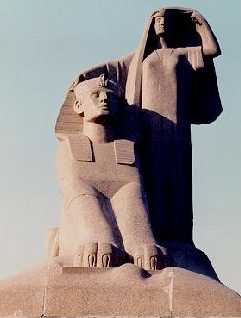Saad Zaghloul Pasha by Mokhtar with (new) Cairo Opera House in background
|
|
|
|
|
Cheers to our "talented" literature prize awardee. Your pain his gain !!!
|
|
|
EGY.COM - ZAMALEK
|
|
Saad Zaghloul Pasha
by Samir Raafat
Cairo Times, 21 June 2001
Egypt's leading sculptor Mahmoud Mokhtar (1891-1934) died a frustrated man. His court case against the government for non-payment of LE 8,000, a very large sum in those days, remained unresolved. The monies in question covered an order he had received in March 1930 from Mustafa el Nahas's Wafd-led government for the production of two larger than life statues of Egypt's nationalist leader Saad Zaghloul Pasha (1858-1927).
In Paris at the time of the said order, Mokhtar traveled to Egypt to hear out what exactly was required of him. An agreement was reached with the ministry of public works on the 19th of the same month and Egypt's leading sculptor set off to produce two model statues. Once these were accepted, he could begin work on the real thing.
As it turns out, the author of The Egyptian Reawakening, that superb granite statue that stands opposite the University Bridge in Giza, was about to make history again.
The stone models duly acclaimed, a contract was signed whereby the two 6.5 meter statues and their respective bases would be produced in France. It was there (rather than his studio on Champlollion Street, Cairo) that Mokhtar set to work on his new marvels.
Yet somewhere along the way, a successor non-Wafd government changed its mind concerning the statue bases. To Mokhtar who had already commenced work, this was a flagrant breach of contract. His had no choice but to resort to the competent courts.
Mokhtar died before the outcome of the litigation.

But more importantly, Mokhtar died before his Zaghloul Pasha statues were simultaneously unveiled on Saturday, 27 August 1938. He would never know they were destined to sit atop landmark sites in both Cairo and Alexandria. In Cairo, the statue faces the father of all rivers at what was then the main entrance to Gezirah via Kasr el Nil Bridge. In Alexandria Zaghloul Pasha's statue faces the Mediterranean and the city's historic eastern harbor.
What better gratification for any Egyptian sculptor, than see his magnum opus at the epicenter of a nation's capital. In this case however we are talking of two statues in rival locations.
As was customary under the monarchy, both court and government spent four months in Alexandria. It was therefore that city's statue that received full honors with the presence of the King himself surrounded by the members of his house, the acting prime minister and the entire cabinet. All turned out to honor the man who had thrown open the way to Egypt's independence.
Naturally, every Wafdist of consequence was present to honor the founder of Egypt's leading party.
From among the two thousand official attendees in the marquee especially set up for the occasion, the only conspicuous absentee was Saad Zaghloul's wife. The Mother of the Egyptians, as Safeya Hanem Zaghloul was known, did not attend due to a seating arrangement blunder. Whereas she was meant to sit next to King Farouk during the official ceremony, grumblings from the more conservative elements among the Moslem clergy resulted in last minute seating changes unbecoming for a lady of her stature and position. Madame Zaghloul stayed at home and listened to a live broadcast of the event instead.
Ignorant of the oversight that took place, the 18-year old King would later call on Safeya Hanem to apologize.
In Cairo, the statue was simultaneously unveiled at 17:00 by Justice Minister Ahmed Khashaba Pasha with a much more popular crowd in attendance. Despite the passing of 11 years since Zaghloul's death and that time honored propensity to confine hero-worshiping to living incumbents only, many citizens had not forgotten the man who had so valiantly fought against the British. Still fresh in everyone's mind was how Zaghloul had instigated an unprecedented general strike in 1919 that brought the entire nation to a grinding stop setting off Egypt's long struggle for independence.
Perhaps, too, there was another reason for attending the Cairo unveiling. The statue stood on an island still considered a virtual British enclave. More importantly, it faced the notorious Kasr el Nil barracks across the Nile where a large British garrison was headquartered and where Zaghloul himself had once been a prisoner.
Despite Zaghloul's efforts and those of his successors, the British still maintained military bases in Egypt. Here again was a chance to poke at that oldest of colonial powers.
Likewise, many onlookers at the Cairo unveiling were preoccupied with the statue itself. Was that Zaghloul in one of his legendary fiery speechmaking postures, or was that him perched up there giving the finger to his sworn enemies watching from their Kasr el Nil base?
But what of the other set of bases subject Mokhtar's litigation? Who then was responsible for the two statues' beautiful granite substructures?
As it turns out the ministry of public works awarded the contract to an Italian contractor, a signor A. Veccia, at an alleged cost of LE 16,000. Aswan granite stone was used in both cases. While the base for the Cairo statue is reportedly 16 meters in height with a circumference of 10 meters, the one in Alexandria stands 12 meters tall.
Whether or not Mokhtar died a frustrated man, thanks to him, Egypt's 'Great Patriot' had been appropriately honored.
|
Reader Comments |
Subject: Saad Zaghloul statues |
|
|
|
|